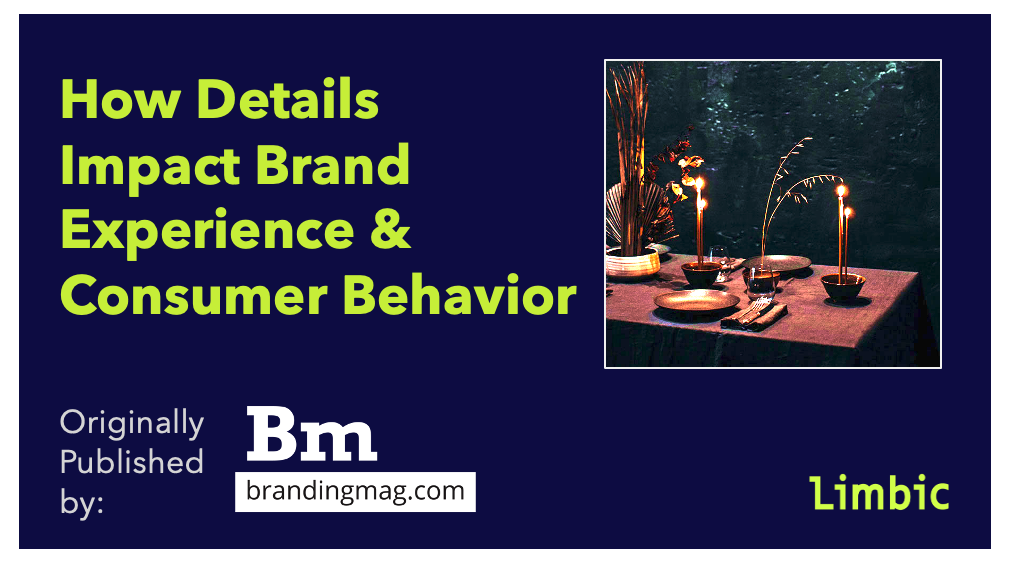How Details Impact Brand Experience & Consumer Behavior
The ability for brands to have a competitive advantage these days is getting slimmer and slimmer. Choices are unlimited and digital experiences are lowering the barriers of entry to most anything. When it comes to attracting and retaining customers, small details have a big impact.
When a brand causes us to endure a bad experience, we get frustrated and offended. We take it personally and it leaves a lasting impression on how we feel about that brand. A 2020 Zendesk study reported that 50% of customers will switch to a competitor after one bad experience, and 80% of customers will switch after a second bad experience.
The opposite is true for brands that make us feel good. In a sea of sameness, when most anything we want is within reach, it all comes down to how an experience makes us feel. Salesforce reported in 2020 that 91% of customers say that good service makes them more likely to purchase from a company again.
The Science Behind Why Details Matter
In order to fully understand why details matter so much, we first should dip into the science of our emotional responses. Our brains are wired to respond instinctively and emotionally as the primary driver of our decisions and our behaviors.
I first became fascinated with the power of our instinctive responses many years ago when reading Why We Buy, by Paco Underhill, a pioneer in shopper marketing research. One study described in the book is around the positioning of a clothing display table in a department store. When the table was placed right next to a main aisle walkway, people spent less time browsing and bought fewer items than they did when the table was set back a few feet away from the walkway. When observing the situation, it became clear that one detail made a big difference – customers did not like it when other customers brushed by them closely, and it caused them to walk away from the table. Once the table was set back from the aisle and other customers were too far away to make contact, the instinctive response to walking away from the table was eliminated and sales increased.
Sound is another example of a detail in brand experience that causes an instinctive response. While leading strategy and research at a sonic branding music studio, I conducted cognitive research studies on the emotional and behavioral impact of sound in experiences. We proved that the way a sound makes you feel at a subconscious level has an 86% correlation to your conscious desire to have that experience again. This research demonstrated that brand experiences with poorly designed sounds (such as alerts, entry sensors, or overhead music) are creating negative emotional responses that cause people to avoid future interactions.
Digging even deeper, I’ve studied cognitive biases. These neurological shortcuts are systematic patterns of deviation from norm or rationality in judgment. In other words, they consistently cause us to make decisions that don’t always seem rational. When brand leaders are aware of these predictable behavioral responses, the details of a brand experience can be adjusted to be more successful.
For example, by understanding the Ambiguity Effect bias, we know that people have more trouble (or avoid) making a decision when the choices are unclear, and that we should help customers by making it easy for them to choose. By understanding the Peak-End Rule, we know that people often judge an experience largely based on how it felt at its most intense peak and at its end, and that we should prioritize delightful moments during and at the end of an experience for lasting impact. There are many other examples of cognitive biases that shed light on important details to consider.
Getting Into the Details – 3 Areas of Focus
The pursuit of fine-tuning details can be an endless one, but here are three focus areas to guide your efforts:
1. Make it Easy
People prefer easy over difficult. Our brains and our behaviors most often instinctively choose the path of least resistance. We appreciate and remember when others make it easy for us to get things done, and we get frustrated when experiences seem to be more challenging than they need to be.
Easy return policies are loved by customers, and brands like American Eagle, Zappos, or Bath & Body Works are known for how easy it is to make returns. They benefit from risk and hassle-free trials. Another way some retailers are making shopping experiences easy is with innovation during the checkout experience. Whether it’s self-serve kiosks, curbside pick-up, or contactless payments, simplifying the checkout experience is a great way to keep shoppers engaged and happy until a sale is finalized. When each detail of the checkout is thoughtfully designed to be easy, fewer people abandon their purchase and more people leave following a great ending to the experience.
Another important way to make a brand experience easy is to proactively address moments of potential stress. FedEx, for example, has learned that giving confidence to people that the package will arrive where and when it is supposed to, significantly improves the experience. As such, they’ve deployed sensor-based technology so that customers can easily track important shipments as they move.
2. Seek Customer Input
Customers are a great source of feedback. They notice details that you don’t, and they experience frustrations that you may not be aware of, which reduces their desire to do business with you.
Pioneered by brands like Starbucks, Dell, and Intuit, crowdsourcing input and ideas has been around for a while. More recently, brands like Uber have built feedback into the heart of their business model. By collecting and prioritizing experience ratings from both drivers and passengers, Uber has managed to create an environment that encourages kindness and leads to better experiences, because every detail of the experience can lead to a more positive or negative rating for either the driver or passenger.
Neuroscience-based research and artificial intelligence (AI) software is also making it possible for us to know and address how people are feeling during an experience. Research techniques that are readily available help brands uncover emotional responses and levels of engagement to stimulus of any kind, from advertisements to brand identity elements to website interactions. This kind of feedback enables brands to fine-tune the details of the experience in ways that lead to more positive emotional responses and greater brand affinity.
One great example is TD Ameritrade, a brand that uses AI to analyze calls in its contact center to improve caller experiences in real-time. The AI software identifies when customers are frustrated or overwhelmed, which instantly adjusts the messaging that the representative uses to proactively address the caller’s concerns. These details have a significant impact on the way callers feel about their interactions with the brand.
3. Prioritize Desirable Brand Experiences
Whether it is in product design, brand identity, messaging, or packaging, brands have an opportunity to fine-tune small details that have a big impact. Sometimes, the opportunity is in the sound of your product, like the sound an iPhone makes when mail is sent, which gives users a sense of emotional satisfaction. Sometimes, it’s in a brand’s use of language, like how Southwest Airlines has created the term “transfarency” to communicate transparent and fair pricing and reward program policies.
Another example that gets a lot of attention, and has earned its own term, is unboxing. Some brands have become well-known for the unboxing experience that they create, such as Apple, Nest, Dollar Shave Club, and Birchbox, to name a few. People look forward to these experiences and even create videos to share their delight. When it comes to unboxing, every detail matters.
Some brands obsess over every detail of their brand experience. One example is Trader Joe’s, which primarily sells private-label groceries at fair prices without sales or rewards programs. Their brand aesthetic is carefully designed, including their use of language, signage, overhead music, product packaging, and Hawaiian shirts. Their employees are known for being incredibly helpful, pleasant, and happy to go out of their way for a customer. Employees collect feedback, are complimentary of customer purchases, and are motivated to create a fun and emotionally desirable environment for everyone. Each detail of the experience is carefully considered.
It’s All in the Details
“The details are not the details. They make the design.”
This famous quote from Charles Eames, who is responsible for groundbreaking contributions in the fields of architecture and design, says it all.
Emotionally appealing experience design comes from insights and ideas that are distilled down to the details that matter most. When it comes to creating desirable brand experiences that stand out from the competition and keep customers coming back for more, it’s all in the details.
Originally published by Brandingmag
Cover image source: Rachel Claire
Featured Articles & Podcasts





